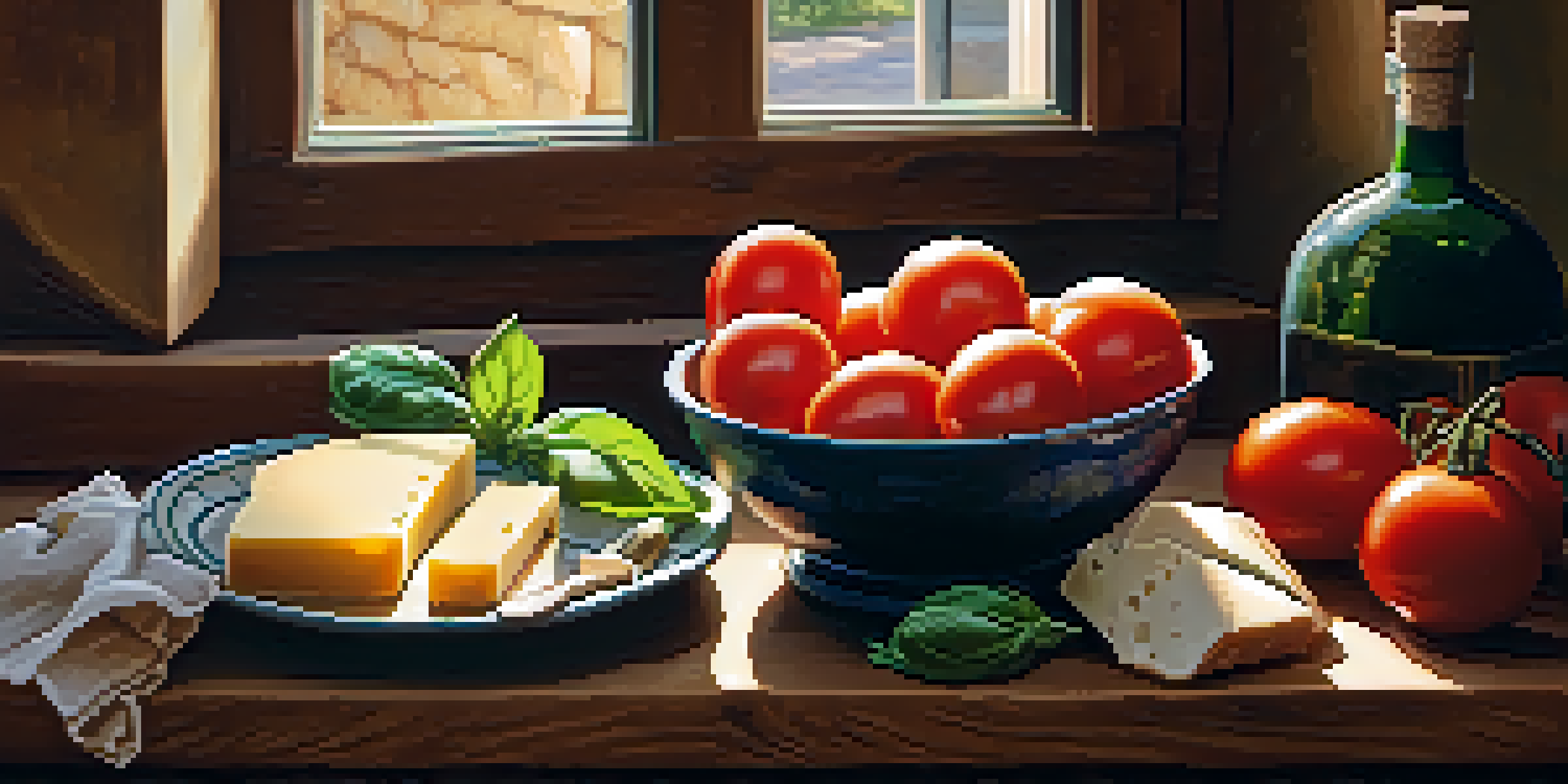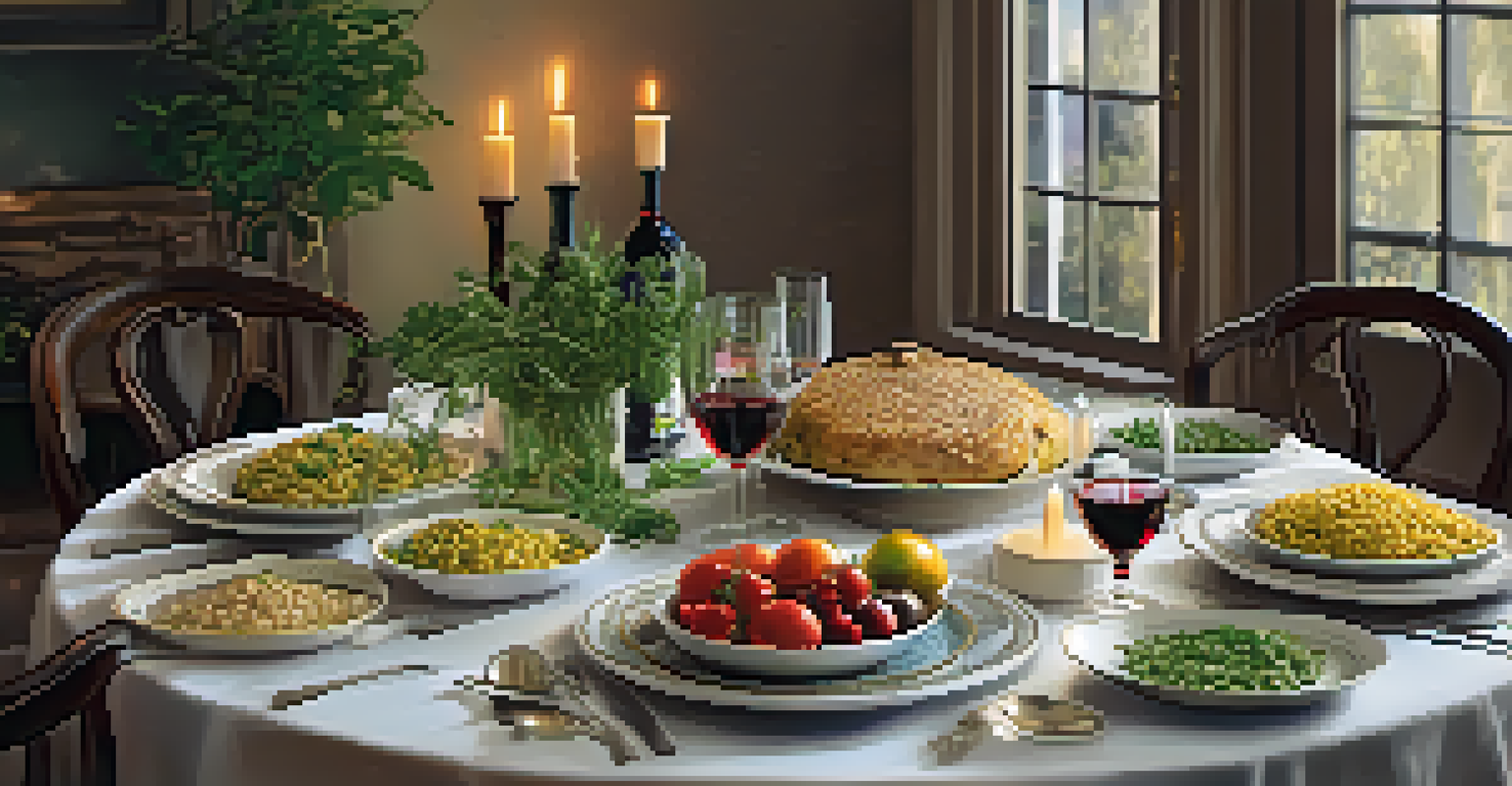Exploring Culinary Traditions: A Journey Through Italy's Regions

The Culinary Heart of Italy: A Regional Overview
Italy's culinary landscape is as diverse as its regions, each with unique flavors and traditions. From the mountainous north to the sunny south, every area contributes its distinct touch to Italian cuisine. Think of Italy as a patchwork quilt, where every piece tells a story through its ingredients and culinary practices.
Cooking is like love. It should be entered into with abandon or not at all.
Each region showcases its history, climate, and local produce, shaping how dishes are prepared and enjoyed. For instance, the rich cheeses of Lombardy contrast sharply with the fresh seafood of Sicily. This regional pride not only influences the food but also reflects the cultural identity of the people.
Exploring these regional cuisines offers a delightful adventure for your taste buds. Whether you're indulging in the hearty polenta of the north or the savory pasta alla Norma of Sicily, every bite is a celebration of local traditions and flavors.
Northern Italy: A Taste of the Alps and Lakes
Northern Italy is characterized by its mountainous terrain and glacial lakes, which influence its culinary offerings. Here, you'll find dishes rich in butter, cheese, and hearty grains. Think of risottos and polenta, staples that provide warmth during the colder months.

The region is also famous for its rich meat dishes, like the famous ossobuco from Lombardy. This slow-cooked veal shank is often served with risotto, creating a comforting and satisfying meal. Additionally, the use of local herbs and truffles adds a layer of complexity to these dishes.
Italy's Regional Culinary Diversity
Italy's cuisine varies significantly across regions, each offering unique ingredients and traditional dishes.
As you explore Northern Italy, don't miss out on the wines, particularly the robust reds from the Veneto and the sparkling Prosecco. These beverages pair beautifully with the rich flavors of the food, completing your culinary journey through the Alps.
Central Italy: The Birthplace of Italian Cuisine
Central Italy is often considered the heart of Italian cuisine, home to iconic dishes and ingredients. Regions like Tuscany and Umbria are celebrated for their rustic flavors, relying heavily on fresh, local produce and simple cooking methods. Here, you'll find vibrant olive oils and hearty beans taking center stage.
Food is our common ground, a universal experience.
Tuscany's famous ribollita, a thick vegetable soup, showcases the region's commitment to using seasonal ingredients. It’s a dish born from necessity, reflecting the peasant roots of Italian cooking and the beauty of making something delicious from simple components.
Moreover, Central Italy is renowned for its pasta dishes, with pici and pappardelle being popular choices. These handmade pastas are often served with rich sauces that highlight the region's local meats and vegetables, creating a comforting yet sophisticated dining experience.
Southern Italy: A Flavorful Mediterranean Influence
Southern Italy is synonymous with vibrant flavors and an abundance of fresh ingredients, thanks to its Mediterranean climate. The region is famous for its tomatoes, citrus fruits, and seafood, which play a significant role in its culinary identity. Dishes like caprese salad and spaghetti alle vongole are perfect examples of this fresh approach to cooking.
Sicily, in particular, stands out with its unique blend of influences from various cultures, including Arab and Spanish. This is evident in dishes like arancini, delicious rice balls filled with cheese and meat, and the sweet pastries filled with ricotta that are a must-try.
The Importance of Dining Culture
Dining in Italy is a communal experience, emphasizing the enjoyment of food as a celebration of life and culture.
Exploring the south also means indulging in its desserts, especially the rich cannoli and cassata. These sweets are not just treats; they tell the story of the region's history and the fusion of flavors that define Southern Italian cuisine.
Sicilian Cuisine: A Melting Pot of Cultures
Sicilian cuisine is a beautiful tapestry woven from the island's diverse history. With influences from the Arabs, Normans, and even the Spanish, Sicilian dishes are rich in flavor and creativity. The use of ingredients like saffron and couscous highlights this cultural blend and adds a unique twist to traditional Italian fare.
One cannot discuss Sicilian cuisine without mentioning its iconic street food, such as arancini and panelle. These tasty snacks are perfect examples of how innovative and delicious food can emerge from humble beginnings, making them favorites for locals and visitors alike.
Additionally, Sicilian desserts, like cassata and granita, offer a refreshing end to any meal. These sweet treats showcase the island's love for fresh ingredients and are a testament to the region’s culinary artistry, making Sicily a true feast for the senses.
Exploring Italian Cheeses: A Regional Delight
Italy is home to a remarkable variety of cheeses, each with its unique character and flavor profile. From the creamy Gorgonzola of Lombardy to the tangy Pecorino Romano of Lazio, these cheeses play a crucial role in the culinary landscape. They are not just ingredients; they are cultural treasures that reflect the traditions of their regions.
Cheese-making in Italy is often a family affair, with recipes passed down through generations. This dedication to craftsmanship results in cheeses that are rich in history and flavor, making them essential components of many Italian dishes, from pasta to pizza.
Wine Complements Italian Cuisine
Local wines enhance the flavors of regional dishes, making wine and food pairing an integral part of the Italian dining experience.
Exploring these regional cheeses can be an adventure in itself. Consider visiting local cheese shops or markets, where you can sample a variety of options and learn about the artisanal processes behind them. Pairing these cheeses with local wines and breads creates a true taste of Italy’s rich culinary heritage.
Wine and Food Pairing: Elevating the Italian Experience
No exploration of Italian cuisine is complete without considering the vital role of wine. Each region produces wines that perfectly complement its local dishes, enhancing the overall dining experience. For instance, a robust Chianti pairs beautifully with a hearty Tuscan ragu, showcasing the importance of pairing good food with great wine.
The practice of wine and food pairing is not just about matching flavors; it's about creating a harmonious dining experience. Italian wines are often crafted to balance the acidity, richness, and flavors of the food, making every meal a celebration of taste.

As you journey through Italy, take the time to explore local wineries and vineyards. Tasting the wines right where they are produced offers a deeper understanding of the region’s terroir and how it influences the food, making your culinary adventure all the more enriching.
The Art of Italian Dining: A Cultural Experience
Dining in Italy is more than just eating; it’s an art form, a social event, and a cherished ritual. Meals are often lengthy affairs, designed to be savored and enjoyed with family and friends. This cultural approach emphasizes the importance of community and connection over simply filling one’s stomach.
The structure of an Italian meal typically includes multiple courses, starting from antipasti to dolce, each showcasing different flavors and ingredients. This allows diners to experience a variety of tastes and textures, making every meal an exciting journey.
Lastly, don't forget the importance of enjoying food with the right mindset. Italians take pride in their culinary heritage, and every meal is an opportunity to celebrate life, culture, and the simple joys of good food.